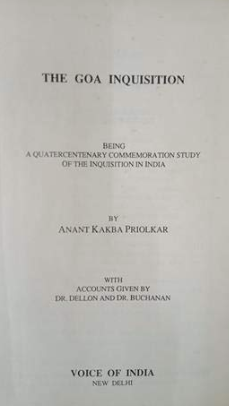The Goa Inquisition
 From Wikipedia - Reading time: 5 min
From Wikipedia - Reading time: 5 min
 Title page for The Goa Inquisition, Being a Quatercentenary Commemoration Study of the Inquisition in India (1961) | |
| Author | Anant Kakba Priolkar |
|---|---|
| Language | English |
| Subject | Goa Inquisition |
| Publisher | Bombay University Press |
Publication date | 1961 |
| Publication place | India |
| Pages | 264 |
| ISBN | 978-0-8364-2753-0 |
The Goa Inquisition, Being a Quatercentenary Commemoration Study of the Inquisition in India is a book published by Bombay University Press and authored by Anant Priolkar. It is a narrative of the Goa Inquisition organised by the rulers of Portuguese Goa.
Details
[edit]Part I
[edit]The book is divided into two parts. Part I, titled "The Goa Inquisition", is divided into ten chapters. The first two chapters detail the Spanish Inquisition and Portuguese Inquisition in Europe providing background material and context that would lead to the inquisition in India. A fictional story of unrequited love is used as the basis for the anti-Semitism of Tomas de Torquemada. The book also makes the origin of the Portuguese Inquisition based on the love of King Manuel I of Portugal for Princess Isabella of Aragon, instead of politics. (The arrival of Jews to Portugal after their expulsion from Spain was a security threat to the Kingdom of Portugal, because Sephardic Jews had an established reputation in Iberia for joining forces with Moors to overthrow Christian rulers.[1])
Chapter 3 begins with the advent of the Inquisition in India, with a discussion of the French spy Dellon's account of the inquisition in Chapter 4. The successive chapters describe the wars that led to the establishment of Portuguese rule in Goa, and the alleged massacre of Hindus during the Portuguese conquest of Goa in 1510. However, various sources claim that only Bijapur Muslims were killed during the conquest, by both the Portuguese led by Afonso de Albuquerque and the local Hindus led by Timoji.[2][3][4]
Successive chapters in Part I also describe the forced conversion of Hindus to Christianity by the Goa Inquisition. Délio de Mendonça claims that the book completely contradicts contemporary historical accounts of voluntary conversions of entire villages in Goa by the various religious orders (Dominicans, Jesuits and Franciscans),[5] but the book doesn't provide[citation needed] any contemporary basis for its version of history. The book details the organization and procedures of the Inquisition and the anti-Hindu laws that were passed in Goa during the inquisition banning Hindu religious ceremonies and customs from being continued by converted Hindus, as well as reducing the status of Hindus to second-class citizens by banning them from public gatherings and so on.
The book also discusses the various methods of torture used by the Inquisition, such as burning by sulphur, water-torture, rape, the use of pulleys to stretch victims and the "strappado" method of torture. The study of Agostino Borromeo from the University of La Sapienza in Roma into the Vatican archives and the subsequent 783-page report[6] denies the allegations made in the book.
Part II
[edit]Part II discusses the accounts of the Inquisition given by Dellon[7] and Buchanan[8] in two separate chapters. Priolkar cites Buchanan as an authoritative source, although Buchanan's work was a Protestant polemic written in the 19th century that denounced Catholicism in Goa and it did not use any historical records.[citation needed]
Reception
[edit]The book has received criticism from some scholars and commentators who argue that it presents a selective and exaggerated account of the historical Goa Inquisition. In a 2020 opinion column published in oHeraldo, the author noted that Priolkar’s work relied heavily on 19th-century European sources, particularly those influenced by anti-Catholic and anti-Portuguese sentiment, and did not adequately consider primary sources or local historical records.[9]
The article contends that the book has contributed to misconceptions about the extent and nature of the Inquisition in Goa. It further argues that works such as Priolkar's are sometimes used to foster communal or political narratives, rather than to foster historical understanding.[9]
Editions
[edit]References
[edit]- ^ Roth, Norman (1994), Jews, Visigoths and Muslims in medieval Spain : cooperation and conflict, pp.79–90, Leiden: Brill, ISBN 978-90-04-09971-5
- ^ Roger Crowley (2015). "19". Conquerors: How Portugal Forged the First Global Empire. Faber and Faber.
For four days without any pause our men have slaughtered…wherever we have been able to get into we haven't spared the life of a single Muslim. We have herded them into the mosques and set them on fire. I have ordered that neither the [Hindu] peasants nor the Brahmans should be killed. We have estimated the number of dead Muslim men and women at six thousand.
- ^ Bulhão Pato, R.A.; Lopes Mendonça, H. (1884). Cartas de Afonso de Albuquerque seguidas de documentos que as elucidam. Vol. 1. Lisbon. p. 26.
Allgums gentios homens principaes, a que os turquos tem tomado suas terras, sabendo a destruição de gooa, decérão da sera onde estam Recolhidos, e vieram em mynha ajudaa e tomarão os passos e camynhos, e todolos mouros que escaparam de goa trouxeram á espada, e nom deram vida a viva creatura.
{{cite book}}: CS1 maint: location missing publisher (link) - ^ de Oliveira e Costa, João Paulo; Rodrigues, Vítor Luís Gaspar (2008). Campanhas de Afonso de Albuquerque: Conquista de Goa, 1510–1512. Lisbon: Tribuna da História. pp. 55–56. ISBN 978-972-8799-93-9.
- ^ Délio de Mendonça (1958). Conversions and Citizenry : Goa under Portugal, 1510–1610.
- ^ Agostino Borromeo (2003). "L'Inquisition de Goa". L' inquisizione : atti del simposio internazionale: Città del Vaticano, 29-31 ottobre 1998. Biblioteca Apostolica Vaticana. doi:10.1400/227364.
- ^ Dellon, G.; Amiel, C.; Lima, A. (1997). L'Inquisition de Goa: la relation de Charles Dellon (1687). Editions Chandeigne.
- ^ Claudius Buchanan (1811). Christian Researches in Asia. Cambridge.
- ^ a b Luis Menezes, Dale (5 July 2020). "Misuse of History: The Inquisition". oHeraldo. Retrieved 7 June 2025.
 KSF
KSF